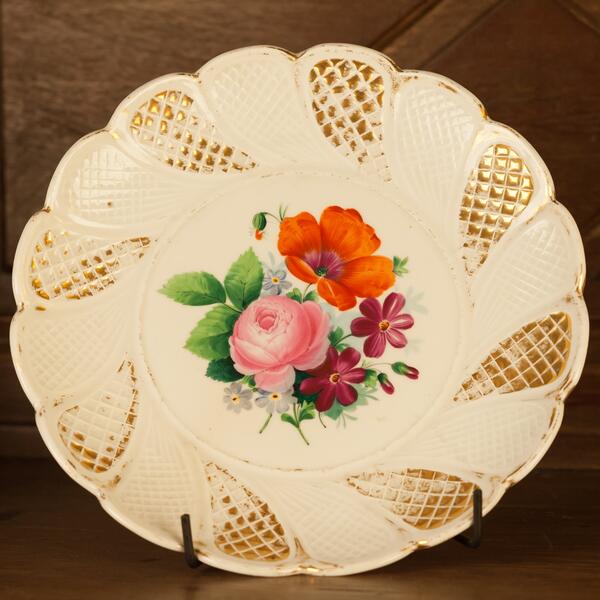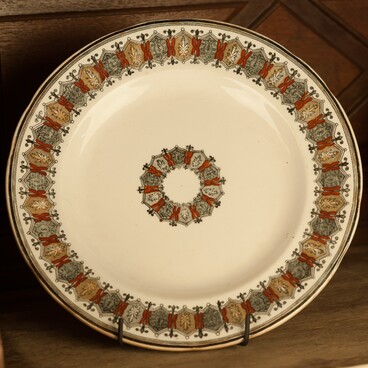This porcelain plate with a relief lip and a polychrome painted ornament was made by Meissen Porcelain Manufactory in Germany. It is an item of common domestic china, which was much in demand in Europe in the second half of the 19th century. Abundance of gold details, combination of gold-plating and painting were all highly fashionable during that period. Meissen china stood for its floral, impressionist-like, patterns and the striking radiance of its white clay. The second half of the 19th century saw the appearance of a new method of porcelain decorating, that is, covering it with multicolor glazing. The development of new, heat-resistant on-glaze paints allowed for vibrant hues that would not fade with time. The pigments were mixed by hand according to a formula that was kept top secret.
Porcelain first appeared in China as a result of centuries of evolving of the ceramics craft. The secret of its production was coveted for ages by Italy, France and England. However, for over 200 years, all the attempts to recreate porcelain had met with failure. True porcelain was finally produced in the early 1700s. In 1710, the first European porcelain manufacture was founded in the German city of Meissen. It was mathematician Ehrenfried Walther von Tschirnhaus (b. 1651 – d. 1708) and alchemist Johann Friedrich Böttger (b. 1682 – d. 1719) who succeeded in discovering the recipe of fine hard-paste porcelain.
The key to success was the precise blending of kaolin (clay mineral) with native feldspar and quartz, which made the European porcelain similar, if not identical to the Chinese original. By 1713, Meissen manufacture had started producing white hard-paste porcelain on a massive scale.
Meissen manufacture has played a key role in European porcelain industry. As it was the first manufacture to produce true porcelain in Europe, it got to define the decoration styles for centuries to come.
Porcelain first appeared in China as a result of centuries of evolving of the ceramics craft. The secret of its production was coveted for ages by Italy, France and England. However, for over 200 years, all the attempts to recreate porcelain had met with failure. True porcelain was finally produced in the early 1700s. In 1710, the first European porcelain manufacture was founded in the German city of Meissen. It was mathematician Ehrenfried Walther von Tschirnhaus (b. 1651 – d. 1708) and alchemist Johann Friedrich Böttger (b. 1682 – d. 1719) who succeeded in discovering the recipe of fine hard-paste porcelain.
The key to success was the precise blending of kaolin (clay mineral) with native feldspar and quartz, which made the European porcelain similar, if not identical to the Chinese original. By 1713, Meissen manufacture had started producing white hard-paste porcelain on a massive scale.
Meissen manufacture has played a key role in European porcelain industry. As it was the first manufacture to produce true porcelain in Europe, it got to define the decoration styles for centuries to come.



